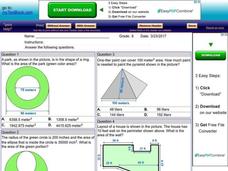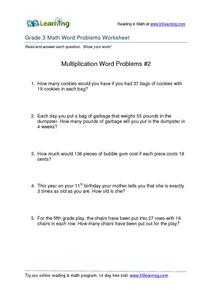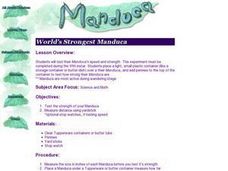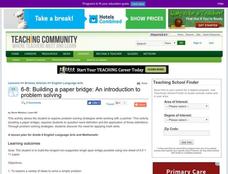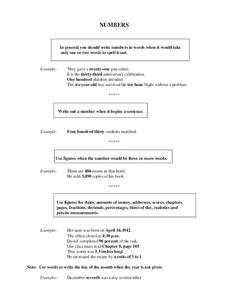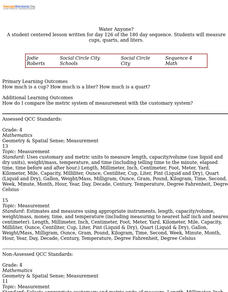Curated OER
Perimeter and Area
In this perimeter and area worksheet, students find the surface area of given polygons. They determine the area of shaded regions. This one-page worksheet contains 10 multiple-choice problems. Answers are provided.
Curated OER
Metric System
Students solve problems using the metric system. In this algebra lesson, students convert between the metric system and the Imperial system. They use these two systems to solve real life problems.
Curated OER
Statistics
In this statistics worksheet, 9th graders solve and complete 10 various types of multiple choice problems. First, they determine the mean number of miles per day that were completed. Then, students determine the data set that has a...
Curated OER
Patterns
Fourth graders investigate patterns and sequences. For this patterns and sequences lesson, 4th graders use a hundreds chart to build recurring patterns. Students skip count by threes and fives on a hundreds chart by coloring...
Curated OER
Rectangle Perimeters
In this measurement activity, 1st graders study the different rectangles and then find the perimeter of each rectangle to the nearest inch.
Curated OER
Area
Third graders find areas of rectangles by using square units, apply knowledge to real-life situations, and simplify method of counting square units by multiplying the length times the width.
Illustrative Mathematics
Floor Plan
A multi-step problem has learners finding the actual area based on a scale drawing and then converting units at the end. Two different solution choices are listed depending on the preference on which step to start first. Both methods can...
Curated OER
I Can Use a Worm to Count
Kindergarteners use worms, puppets or other props to practice counting to 100. First, they listen to a read aloud of Count Worms by Roger Hargeaves. A worm pattern is used to count to 100, with each segment of the worm...
Curated OER
I Wonder How Fast Manduca Grows Compared To Me
Students study the Manduca bug and its growth data. They look for patterns and compare their own growth rate to that of the Manduca.
K5 Learning
Multiplication Word Problems #2
If your mom is three times older than you are, how old is she on your 11th birthday? Young mathematicians answer this and four other multiplication word problems using real-life scenarios. They consider bags of cookies, pounds of...
Curated OER
Mean, Median, Mode, Range
Learners engage in a study of mean, median, mode, and range in order to represent data in tables. They are also exposed to the results of data that is skewed because of the outlier.
Curated OER
World's Strongest Manduca
Middle schoolers test the strength and speed of their Manduca. They keep their insect in a small dish and wiegh it down with pennies. They share their observations with the class.
Curated OER
Add and Subtract Mixed Numbers Quiz
Use this mixed number worksheet to have your charges complete a set of 13 problems, adding or subtracting mixed numbers. Answers are included on page 2, a reference web site is given for additional activities.
Curated OER
Tick Around the Clock
Students examine and discuss the differences between clocks they are shown. Using the internet, they research how people used to tell time before clocks. They review what the long and short hand on the clock represent and practice...
Curated OER
Building a Paper Bridge: an Introduction To Problem Solving
Eighth graders explore problem solving strategies to build a paper bridge with a partner. As a class they discuss a variety of techniques to solve a simple problem, then in pairs construct the longest non-supported single span bridge...
Key Curriculum Press
Lesson 10.2 Volume of Prisms and Cylinders
Tenth graders investigate volume in class and in the real world. They explore volume of cylinders and prisms as it relates to different subjects. Pupils also investigate how important volume is in different career field.
Futures Channel
Folding Circles
Students investigate properties of circles. In this geometry lesson, students differentiate between similarity and congruence as they observe polygons. They investigate properties of two and three dimensional shape.
Curated OER
Sequencing From Close To Far
Students explore how objects stay the same size and only "look" like they change when closer are farther from the object. They sequence aerial photos and satellite images from closest to farthest.
Curated OER
Building a Telescope
High schoolers construct a simple refracting telescope. They calculate the magnification.
Curated OER
Cap-It to the Max
Eighth graders compare the volume of three cylinders constructed from the same size sheet of paper. They use concrete and graphical models to derive formulas for finding perimeter, circumference, area, and volume of two and three...
Alabama Learning Exchange
Origami Geometry
Origami is an excellent way to combine Japanese culture, art, and geometric shapes into one engaging instructional activity! Scholars begin by listening to the story Sadako and the Thousand Paper Cranes and learn the origin of...
National External Diploma Program Council
Numbers
The written form for 345 is three-hundred forty-five, where as the word form for 70% is seventy percent. Here, young mathematicians read 10 sentences and write the word form of each number in the sentences.
Curated OER
How Tall in the Fall?
First graders use nonstandard measurement to measure. After reading Inch by Inch, 1st graders pair measure leaves that they have collected. They glue their leaves onto tag board to make a display.
